References
Asthma Symptoms (2018) Abnormal Breathing Patterns — Asthma Issues. Available online at: www. asthmasymptoms.org
Booth A (2015) Routine management of asthma in primary care. Respir Care Today 1(1): 26–31
British Thoracic Society, Scottish Intercollegiate Guidelines Network (2016) British guideline on the management of asthma. Available online: www.britthoracic.org.uk/document-library/clinicalinformation/asthma/btssign-asthmaguideline- 2016/
Claus AP, Hides JA, Moseley GL, Hodges PW (2009) Different ways to balance the spine: subtle changes in sagittal spinal curves affect regional muscle activity. Spine 34(6): E208–214
Cydulka RK, Bates CG (2013). Asthma. In: Adams JG, ed. Emergency Medicine. 2nd edn. Elsevier Saunders, Philadelphia, PA: Chap 48
da Silva Paes FG, Filho NS, Custodio Neto da Silva MA, et al (2016) Effect of urinary incontinence on the quality of life of asthmatic women. J Asthma 53(5): 553–8. Available online: www.tandfonline.com/doi/abs/10.3109/02770903.2015.1108439
Durrani SR, Busse WW (2014) Management of asthma in adolescents and adults. In: Adkinson NF, Bochner BS, Burks AW, et al, eds. Middleton’s Allergy Principles and Practice. 8th edn. Elsevier Saunders, Philadelphia, PA: Chap 55
Fishwick D, Barber CM, Bradshaw LM, et al (2008) Standards of care for occupational asthma. Thorax 63(3): 240–50
Gibson PG, Powell H, Wilson A, et al (2003) Self-management education and regular practitioner review for adults with asthma. Cochrane Database Syst Rev 2003; (1): CD001117
Hodges PW, Sapsford R, Pengel LH (2007) Postural and respiratory functions of the pelvic floor muscles. Neurourol Urodyn 26(3): 362–71
Lugogo N, Que LG, Gilstrap DL, Kraft M (2016) Asthma: clinical diagnosis and management. In: Broaddus VC, Mason RJ, Ernst JD, et al, eds. Murra¡y and Nadel’s Textbook of Respiratory Medicine. 6th edn. Elsevier Saunders, Philadelphia, PA: Chap 42
McDermott P (2010) Stress incontinence. J Community Nurs 24(3): 8–14
Medline Plus Trusted Health Information for You (2017) Asthma. Available online: https://medlineplus.gov/asthma.html. (accessed 12 November, 2017)
National Asthma Education and Prevention Program Expert Panel Report 3: Guidelines for the Diagnosis and Management of Asthma. Rockville, MD. National Heart, Lung, and Blood Institute, US Dept of Health and Human Services; 2007. NIH publication 08-4051. Updated 2012. Available online: www.nhlbi.nih.gov/files/docs/guidelines/asthgdln.pdf
NHS Choices (2016) Asthma. Available online at: www.nhs. uk>conditions>asthma
National Institute for Health and Care Excellence (2015) Incontinence — urinary, in women: Managing stress incontinence, management of a woman with predominantly stress incontinence. NICE, London. Available online: https://cks.nice.org.uk/incontinence-urinary-inwomen#!scenario
Oxford University Hospitals NHS Trust (2013) A guide to the pelvic floor muscles — women. Available online: www.ouh.nhs.uk
Royal College of Physicians (2014) Why asthma still kills: the National Review of Asthma Deaths (NRAD) Confidential Enquiry Report. RCP, London
Sapsford RR, Richardson CA, Maher CF and Hodges PW (2008) Pelvic floor muscle activity in different sitting postures in continent and incontinent women. Arch Phys Med Rehabil 89(9): 1741–7
Sims EJ, Price D, Haughney J, Ryan D, Thomas M (2011) Current control and future risk in asthma management. Allergy Asthma Immunol Res 3(4): 217–25
Stonham C (2015) Personalised asthma action plans for patient education and self-management. J General Practice Nurs 1(1): 60–4
Tingley B (2017) 5 side-effects of suffering from asthma. Available online: www.helthprep.com/conditions/s-side-effectsof- suffering-from-asthma. (accessed 12 November, 2017)
Vann M R (2011) Can smoking cause embarrassing bladder problems? Available online: www.everydayhealt.com

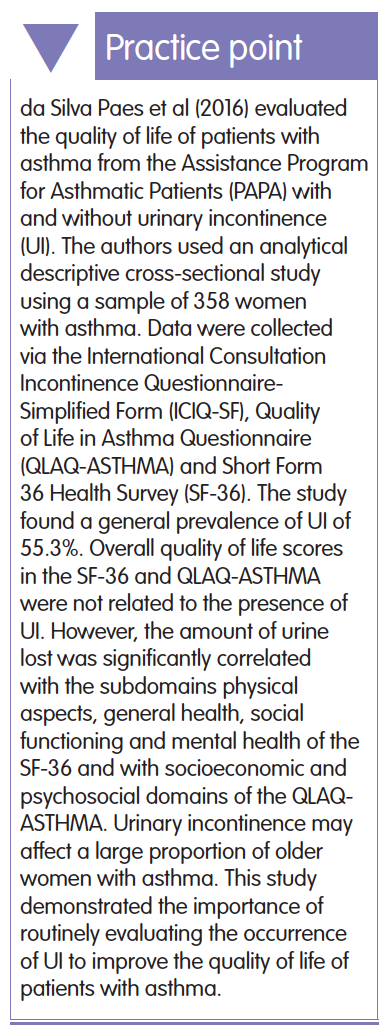
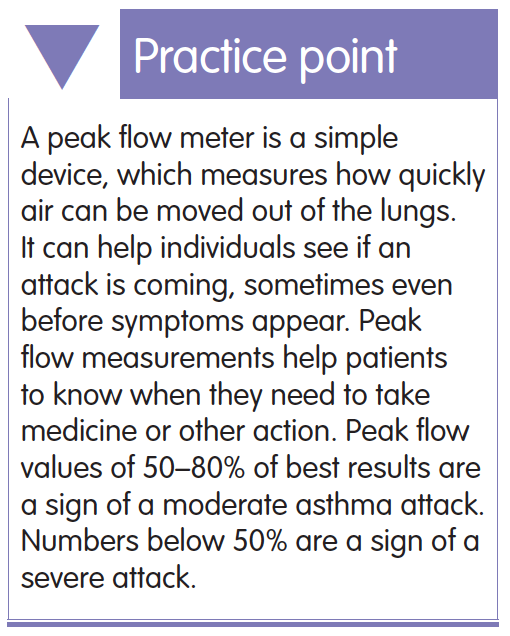 Most people with asthma have attacks separated by symptom-free periods, i.e. it is a variable condition (Booth, 2015). Some people have long-term shortness of breath with episodes of increased shortness of breath, and either wheezing or a cough may be the main symptom. Asthma attacks can also last for minutes or days, and can become dangerous if airflow is severely blocked (NHS Choices, 2016; Medline Plus Trusted Health Information for You, 2017; Asthma Symptoms, 2018). Symptoms of asthma include: cough with or without sputum (phlegm) production, pulling in of the skin between the ribs when breathing (intercostals), shortness of breath which gets worse with exercise or activity, and wheezing (Lugogo et al, 2016; Asthma Symptoms, 2018).
Most people with asthma have attacks separated by symptom-free periods, i.e. it is a variable condition (Booth, 2015). Some people have long-term shortness of breath with episodes of increased shortness of breath, and either wheezing or a cough may be the main symptom. Asthma attacks can also last for minutes or days, and can become dangerous if airflow is severely blocked (NHS Choices, 2016; Medline Plus Trusted Health Information for You, 2017; Asthma Symptoms, 2018). Symptoms of asthma include: cough with or without sputum (phlegm) production, pulling in of the skin between the ribs when breathing (intercostals), shortness of breath which gets worse with exercise or activity, and wheezing (Lugogo et al, 2016; Asthma Symptoms, 2018).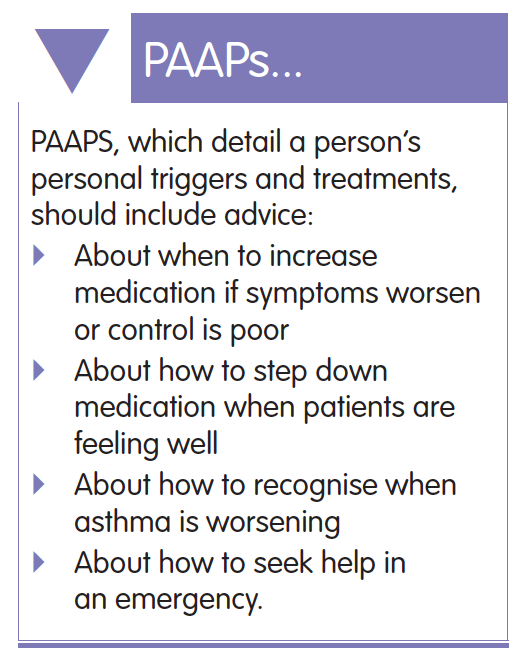 The goals of treatment are to control airway swelling and enable patients to carry out normal activities of daily living without asthma symptoms. It is vital that people with asthma and healthcare professionals work together to manage the condition.
The goals of treatment are to control airway swelling and enable patients to carry out normal activities of daily living without asthma symptoms. It is vital that people with asthma and healthcare professionals work together to manage the condition.
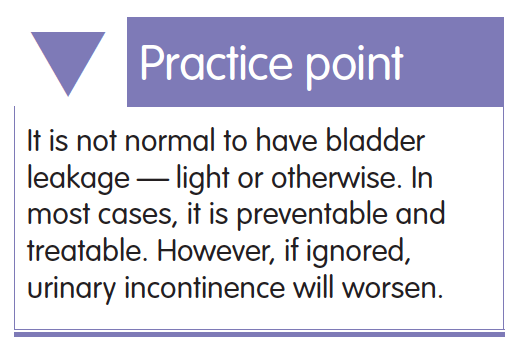 There is no cure for asthma, although symptoms sometimes improve over time. In the author’s experience, with proper self-management and adherence to treatment, most people with asthma can lead a normal life.
There is no cure for asthma, although symptoms sometimes improve over time. In the author’s experience, with proper self-management and adherence to treatment, most people with asthma can lead a normal life.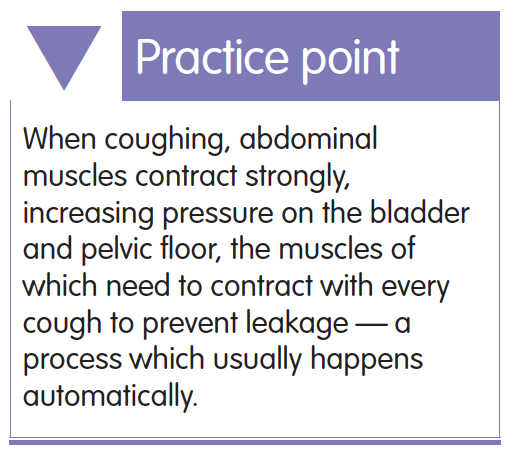
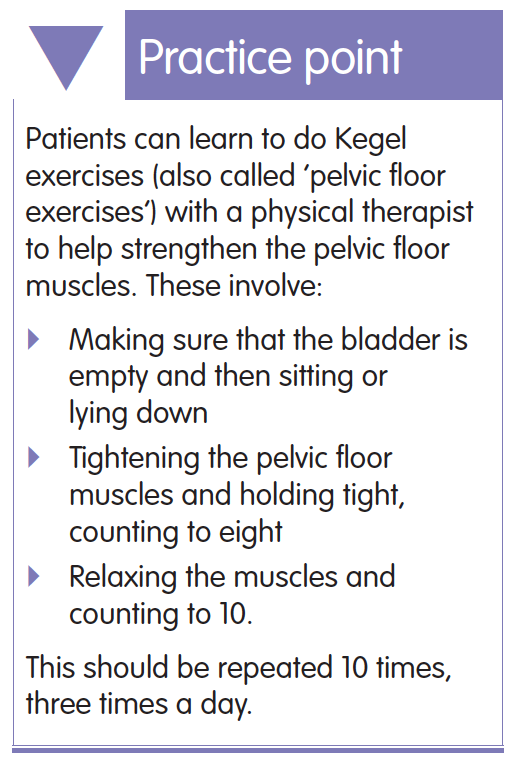 One of the most important things that can be done to help prevent SUI from happening is to strengthen the pelvic floor muscles. These are the slingshaped muscles suspended from the tail bone (coccyx) to the pubic bone at the front and between the sitting bones. These muscles support the pelvic contents (bladder, uterus and back passage) and, most importantly, help close off the bladder and rectum.
One of the most important things that can be done to help prevent SUI from happening is to strengthen the pelvic floor muscles. These are the slingshaped muscles suspended from the tail bone (coccyx) to the pubic bone at the front and between the sitting bones. These muscles support the pelvic contents (bladder, uterus and back passage) and, most importantly, help close off the bladder and rectum.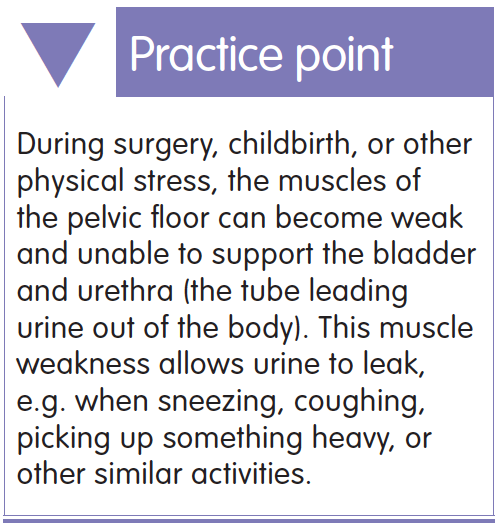 ‘The knack’ is a technique where the pelvic floor muscles are tightened and lifted before huffing or sneezing to protect against leakage. This needs to be performed correctly, lifting the muscles, not pushing downwards. Patients may need the help of a specialist continence physiotherapist to learn how to do this. It is suggested by specialist continence physiotherapists that all patients with bronchiectasis practice ‘the knack’, whether they have UI or not.
‘The knack’ is a technique where the pelvic floor muscles are tightened and lifted before huffing or sneezing to protect against leakage. This needs to be performed correctly, lifting the muscles, not pushing downwards. Patients may need the help of a specialist continence physiotherapist to learn how to do this. It is suggested by specialist continence physiotherapists that all patients with bronchiectasis practice ‘the knack’, whether they have UI or not.